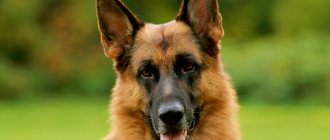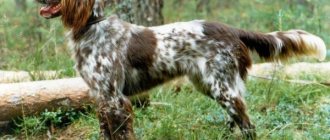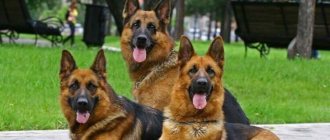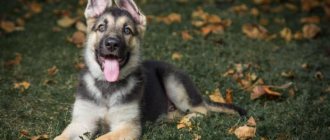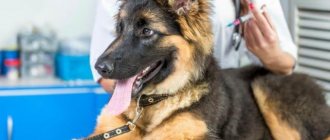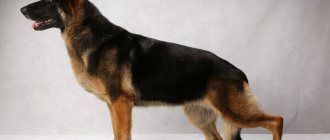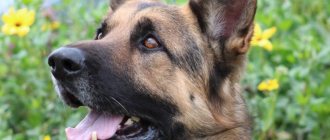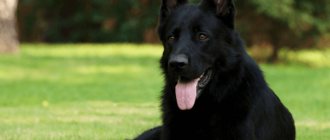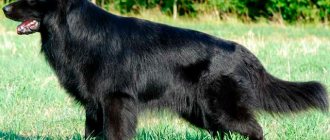As an independent breed, the German Shepherd began its history deep in the past. In Western European territories, skeletons of Bronze Age dogs were found that resembled the remains of a small Indian wolf. He became the progenitor of the German Shepherd living in our time. Based on these findings, it can be assumed that the “bronze” dog was due to the crossing of a wolf and a European dog. You will find out what the further origin of the German Shepherd breed is in this article.
Origin of the word shepherd
The Shepherd is a fairly common breed whose name is well known to everyone. But where did the word “shepherd” come from? If you look at the history of the German Shepherd breed in detail, you will understand that it got its name for a reason. In ancient times, sheepskin was the name given to processed sheep skin. Therefore, this word gave the name to individuals who tended flocks of sheep and protected them from wild animals and people who might covet the cattle. By the way, the ancestor of the breed was the Hofowart, which came from crossing an ordinary European dog and an Indian wolf, which is a predatory animal.
Indian wolf
In general, these animals began to be mentioned in historical sources around the 16th century. It was written about them that they are quite powerful and strong dogs with a death grip. It’s not for nothing that their ancestor was a predator.
The first amateur community
The gross development of dogs occurred at the end of the nineteenth century. Dog breeders organized clubs of different breeds and held exhibitions.
On December 16, 1891, a society of German Shepherd lovers was created, the initiators of which were Count Hahn and Citizen Richelmann. The union was called “Phylax” and the first shepherd breed standard was created.
The society did not last long, since the main purpose of the club was commerce. But thanks to the history of this society, the world paid attention to the German Shepherd.
First attempts at selection
Why did the dog become known as the German Shepherd? The number of German Shepherds began to increase increasingly in German cities in the 18th century. The thing is that at that time sheep breeding began to develop rapidly. People raised sheep, goats, horses and pigs. Accordingly, more and more dogs were required to herd and protect them, because there were at least two individuals per dog.
The fact that the breed appeared in Germany influenced its name. But it was far from perfect, so farmers tried to improve the functional qualities of its representatives.
Such dogs were bred in two districts of Germany. These were southwestern Thuringia and Württemberg. Of course, the animals differed in their disposition, character, and appearance:
- The shepherd dogs of southwestern Thuringia were quite active, sometimes even angry. They had an average build with not long and not thick hair. The fur had a darker color that was similar to that of a wolf. The dogs had long erect ears.
- The dogs of Württemberg, in comparison with their counterparts from Thuringia, on the contrary, were more balanced and had a calm character. They had thick and long fur, and their color was black and red. These dogs had drooping ears and a large build.
In the nineteenth century, German Shepherds began to be mixed with other breeds of herding and cattle animals. For example, with such early bred dogs as: collie, moody, welsh corgi. By the way, here you can read interesting material about raising and training a German Shepherd.
Appearance
What does the animal look like? Breed standard.
The head is wedge-shaped, with a long face. Nose is black. The eyes are medium-sized, almond-shaped, set slightly obliquely, not protruding. The color is dark. The ears are straight, medium-sized, parallel, cone-shaped. Powerful mouth with a scissor bite. The upper incisors closely overlap the lower ones. The teeth are strong, light, there are 42 of them.
— Advertising —
The neck is strong, muscular, neat and relatively long. It is proportional in size to the head, without loose folds of skin. The back is straight and well developed. The chest is moderately wide and deep. Forelegs: shoulder blades long, sloping, placed flat. When viewed from all sides, the legs are straight. The hind legs are parallel, with muscular thighs. The tail should reach at least to the hock joint.
Males are usually larger than females. The normal weight of individuals is 22-40 kg, height is 55-65 cm.
The breed has a thick double coat of coat that protects from the elements. The outer coat is harsh, while the undercoat is fluffy, soft and dense. The head, inner ear and forehead, as well as the legs and paws are covered with short hairs. The neck comes with longer and thicker hairs.
Most common colors:
- Black.
- Black and red.
- Sobolinaya.
- Brown.
- Rare: gray color.
Black and zoned are special names for popular coat colors.
Where was this breed developed?
The very first exhibition at which individuals of this species participated and were shown took place in 1882 in the German city of Hanover.
Then the breeders announced that they had bred dogs with new qualities. It was a male and a female. They were given the nicknames Pollux and Prima. The dogs looked like wolves, but at the same time they were calm and psychologically balanced. They originally came from Thuringia. Dog handlers became seriously interested in these dogs; the bitch and the male aroused interest among dog breeders due to the combination of a developed guard instinct, endurance, and obedience.
Boy
The average weight of a male is 30-40 kg, height is 60-65 cm.
The male is taller, larger and heavier than the female. It has a large head and a wider body.
Males love to dominate, they are proud, while females are more affectionate and gentle. Males are also more territorial towards their home, yard, property and owners.
He prefers to communicate with his authority figure, who spends the most time with him. Despite the fact that he loves every member of his family.
Because males like to dominate, their training can be more challenging.
Boys will need more food than girls due to their larger size.
Max von Stefanitz and breeding a different type of dog
At the end of the 19th century, an important event occurred in the history of the German Shepherd. The military man Max Emil Frederick von Stephanitz, being an expert in this field, became interested in shepherd dogs and decided to breed a different type of breed that did not exist before.
He knew almost everything about the representatives of this breed, which helped him achieve significant success in this matter. In addition, he had a veterinary education. The man believed that it was possible to combine in a shepherd dog not only high endurance, the ability to work until exhaustion, and a strong character, but also good ability to learn commands and the ability to obey a person.
In the spring of 1899, von Stefanitz bought a male dog at a dog show, to whom he gave the nickname Horand von Grafrath. He registered it as a new specimen of the breed. This dog looked like a wild wolf. But the breeder said that such dogs could become the basis of a new breed, including the best, but difficult to compatible qualities. However, other breeders thought differently. They said that wolf-like shepherds were not the dogs that could become the basis of a new breed. But the male became the progenitor of the modern German Shepherd. And the baron was the one who bred animals not for his own selfish purposes, but purely out of love for the breed.
Nutrition
It is also important to understand how you will feed your pet.
Dogs have a more difficult time digesting food due to the fact that they have a relatively small intestine. Therefore, animals need a balanced diet that will help avoid allergies, hip dysplasia or bloating.
Adult pets need to receive protein, fats, carbohydrates, fiber, vitamins and minerals. Quality dog food always contains the right balance of each nutrient.
What are the above substances needed for?
- Protein: for the growth and development of the body as a whole.
- Carbohydrates: to maintain energy.
- Fats: for energy production.
- Vitamins and minerals: for general health.
- Fatty acids: for a shiny and beautiful coat.
Active individuals need to receive 1800-2400 calories per day. For older people or less active people, 1300-1600 calories per day is enough.
Choosing the right food is not difficult. The first ingredient on the label should be a source of protein. Chicken, beef and fish are excellent choices. But there are individuals who are allergic to one of these three protein sources. Therefore, always read the labels on the package before purchasing.
The list of the most common food allergies in the breed also includes corn and wheat. Therefore, it is better to avoid feeds containing these grains. Food dyes, preservatives and other chemicals can also cause allergies. Many German Shepherds are allergic to dairy products, eggs, and soy.
If you notice that your pet has intestinal problems or is constantly itching, try changing the brand of food. Choose one that has completely different ingredients as the main source of proteins and carbohydrates.
What cereals can you give your pet?
Give the individuals rice, buckwheat, millet, oats, millet. Do not feed your pet a mixture of corn and wheat. Firstly, dogs may be allergic to these components. Individuals are also at high risk of stomach distension caused by these grains. Bloat can be fatal.
If your dog refuses food for a day or more, contact your veterinarian immediately.
Feed
Which food is better to give to an animal: dry food or wet food?
There are many good dry and wet foods available. Many people find it difficult to choose between these two types of products. Wet food sometimes contains raw pieces of meat or other foods and may seem like a better option.
Dry food is generally a decent choice if your German is young. Dry foods have some benefits for dental health. Its texture helps remove and prevent plaque formation, especially in youth. Chewing dry food helps build strong jaw bones and muscles. In general, dry food is more convenient.
An older animal will have difficulty chewing due to missing teeth or problems with them.
It is possible to combine dry and wet food.
Many owners feed their dogs raw food. They claim that raw meat and vegetables are what a dog would eat if it lived in the wild. However, dogs that live in the wild rarely live more than four or five years. Also, domesticated animals are quite different from wolves and wild dogs, so feeding them exactly the same food is not always acceptable.
Foundation of the union
That same year, von Stephanitz and his close friend Arthur Mayer created the German Shepherd Society in Wendsbeck. They traveled to different cities in Germany and looked for bitches that they thought were healthy and promising animals, and could serve as the basis for the continuation of a new breed. In addition, friends and their colleagues created their own selection standards, which included parameters of the breed’s performance, while retaining some of the previously formed standards. Thus, a huge breeding work was carried out.
In addition, Max von Stefanitz came up with 6 main rules for creating a new breed, which modern breeders should follow:
- Creativity is almost never combined with profit. Therefore, when breeding new breeds, it is necessary to do this out of great love for animals, and not for money. At the same time, it is possible to control the entire development process only if there is a huge amount of time devoted to work.
- To create a high quality breed, it is necessary to use only dogs that are physically and psychologically healthy. An animal must be raised and raised not only with the owner, but also in his absence.
- Saving money on the health of the animal is strictly prohibited, as is breeding purely champion dogs.
- It is worth choosing females and males not so much from champion lines, but from healthy and proven ones.
- Shepherd dogs that have suffered a serious illness or psychologically unstable individuals are not suitable for further breeding.
- It is not advisable to interbreed close relatives. This may have a negative impact on the quality of the breed.
Features of feeding and diet
A well-designed diet is the key to good health for your pet. The best choice would be balanced premium food, which contains all the necessary microelements and vitamins for the harmonious development of the body. If preference is given to a diet made from “live” foods, then some rules should be followed.
Proteins make up the first third of the diet, the second third is carbohydrates in the form of porridge (best from rice, buckwheat), another third of the daily intake is allocated to various vegetables and fermented milk. Veterinarians do not recommend whole milk as it causes digestive upset in adult dogs.
List of foods useful for shepherds:
- lean poultry meats;
- beef, boiled pork, rabbit;
- raw eggs, omelettes (1-2 times a week);
- fish (once a week);
- cereals;
- potatoes, corn only in raw form;
- vegetables, stewed, boiled cabbage;
- porridge with water or with the addition of milk (half with water).
Fermented milk products (cottage cheese, yogurt, kefir) will be beneficial. Berries, nuts, and peeled seeds are allowed in small quantities. Food temperature should be room temperature.
It is advisable to exclude:
- smoked products, semi-finished products in the form of sausages;
- spiky, tubular bones;
- sweets, dough products;
- grapes, raisins, walnuts, acorns, pistachios;
- too salty, peppery foods;
- millet, semolina, corn grits.
You need to feed at the same time twice a day. Puppies are fed about six times a day. Water must always be available. These principles will help keep your furry friend in good condition, maintaining his health and strength.
How a shepherd became a service dog
Since the working qualities of the individuals were very important, it was necessary not to leave the dogs without work. At the same time, the number of pastures began to decline sharply. Therefore, Max von Stefanitz began to look for other options for using representatives of the breed. He suggested using animals for police service. The dogs quickly got used to their new responsibilities and became good helpers in law enforcement. Soon the military recognized the German Shepherd as a dog capable of serving in the army.
1901 can be considered the first year of service of such dogs in the German armed forces.
Popular nicknames
The first important event after birth for a German Shepherd puppy is naming. You need to approach this responsibly and take your time.
The most popular nicknames for girls:
- Linda;
- Asya;
- Laura;
- Grace;
- Fanya;
- Bonya;
- Torrey;
- Elsa;
- Burn;
- Eve.
Boys' nicknames:
- Rex;
- Golf;
- Phoenix;
- Mark;
- Volcano;
- Donya;
- Max;
- Raleigh;
- Gray;
- Bucks.
The nickname should consist of two syllables, be simple and pronounceable, and be liked by all family members and the dog. A list of beautiful names for a German can be found here.
Sheepdog in World War II
In April 1936, Max von Stefanitz passed away. But his business did not die. It continued thanks to the efforts of the veterinarian's colleagues and friends.
During the Second World War, most of the shepherd breeding organizations ceased to exist. But like-minded people of von Stefanitz managed to save the breed from extinction, promptly restoring the number of dogs in the post-war years.
The first exhibition after the war was held in 1946, where it was decided to create a selective class to increase the base of the best representatives of the breed. Also read our article on feeding your German Shepherd.
Division of dogs into high and working breeding
In the 60s, two lines appeared in the breeding of the breed: high and working breeding. Working breeding is based on the physical, athletic qualities of the dog, while breeders pay less attention to the aesthetic appearance of the animal. Participation in competitions is important, as well as the compliance of representatives of the breed with indicators of physical activity, balance and absence of diseases.
The high or show direction is guided, in addition to the physical condition of the animal, by the standards of the dog’s exterior. These are the animals that take part in exhibitions.
Theses
- This is an active, intelligent dog. To keep her happy and calm, the owner must exercise her both physically and mentally. Games, learning or work - that's what she needs.
- Regular exercise is required, otherwise the dog will get bored and this will result in negative behavior.
- They are suspicious and distant towards strangers. In order for a dog to grow up calm and confident, it is necessary to carry out early socialization of the puppy. New places, smells, people, sounds, animals will help him in the future.
- These dogs are great for service, but are not recommended for those who are getting a dog for the first time.
- They shed throughout the year, so you need to comb out the dead hair regularly.
- It is advisable to take a training course, this will help you get a controllable dog.
- They perfectly protect their territory and family, but do not forget that without proper socialization and training they can attack random people.
German Shepherds in the USSR after the revolution and during the Great Patriotic War
In the post-revolutionary years, a large number of dogs were brought to the Soviet Union for the activities of the People's Commissariat of Internal Affairs and border troops. But the imported animals turned out to be not quite the same as they were before the crisis in cynology. A crisis occurred in Germany in the 20s, when unscrupulous breeders, in pursuit of profit, without giving due importance to the quality of the shepherd breed, crossed them with other dog breeds. They thought only about their own benefit and often did not monitor the health of the animals. In view of this, the dogs had obvious defects in psychological education: they were either cowardly, or, on the contrary, too angry. There weren't many good dog handlers in the USSR, which made it difficult to breed a breed that meets Western standards.
After the Second World War, there were very few dogs left, brought by the fascist invaders. On the other hand, the government received instructions to breed animals for their further use in the army. It is important to note that the breeders faced some mental difficulties. After the war, people had bad associations with the word “German”; the shepherd was considered an enemy animal. In addition, they guarded the camps.
FAQ
I want to get a German Shepherd, but they say it is a dangerous dog. Is it so?
The Shepherd is an ideal watchman, security guard and bodyguard. The owner is everything to her. A dog poses a danger to any stranger who behaves inappropriately. Taking on such an animal is a big responsibility. If the dog thinks that its owner is in danger, it will immediately attack the stranger.
A child asks for a German Shepherd for his 14th birthday. He wants to deal with it himself, can he handle it?
No, don't take that responsibility on yourself. The shepherd will perceive the child as his puppy and protect it in every possible way. The dog may consider the hand of a school friend extended to greet him as a threat. The child will not cope without the participation of parents or a dog handler.
How to choose a German Shepherd puppy?
It's difficult to give advice. The main thing you need to pay attention to is: find out the reputation of the nursery, ask for documents from the parents, find out their titles, inquire about the number of puppies in the breeding (the fewer, the stronger they are), examine the physique of the puppies and their parents.
How difficult is it to care for a German Shepherd?
If you are not afraid of daily active walks in the fresh air with active physical training, exercises on the dog park. If you are not afraid of large volumes of shedding fur and are ready to feed your dog the best food or fresh meat, then caring for it is not difficult.
Does NO's hair shed a lot when shedding?
Shepherds shed a lot, which is especially problematic in the spring. You will have to constantly brush the fur. This should be done on a regular basis during and outside the shedding season.
At what age can you start training German puppies?
Dog handlers recommend starting training in basic course commands from the age of three months. Earlier training may not give the desired result.
We adopted BUT from the shelter. She is 2.5 years old. The dog is very active, always on edge, is this normal?
If you have a purebred shepherd, then this is how it should be. This is an indicator of her health. Another thing is that you need to arrange many hours of active exercise with her on the street, teach obedience and work commands, and take her to the playground. The dog needs physical activity and work.
I'm confused by the red color of my dog's fur. Maybe they sold me a non-purebred dog?
No, this should not bother you if the back of the animal is black. There are dogs of zonal-red, fawn and black-and-white color.
We took the dog BUT to guard our country house. He's already 5 months old, but he doesn't bark at anyone?
What do you want from your child? Of course, at 5 months a German Shepherd puppy is already quite big, but it is a child. Wait for him to grow up and mature. Will get used to family members. Learn to distinguish between friends and strangers. Shepherd dogs begin to be trained for protection only at 1 year of age, when the dog’s psyche is fully formed. If you need an empty-headed dog, you should have taken a mongrel. A security guard must be trained by a specialist.
Is it possible to keep a German in an apartment?
If you want, you can. Provided that you can provide your dog with sufficient physical activity and regular active walks. And you yourself are ready to constantly vacuum sofas, carpets and armchairs - the dog will produce a lot of hair.
At what age do BUT ears stand up?
This usually happens within six months. If the ears do not stand up before this age, then most likely the problem is not very good genes.
Is the breed suitable for outdoor use only?
Yes. If the following conditions are met:
- the yard area should be surrounded by a high, solid fence;
- the enclosure must have a roof;
- The dog must have an insulated kennel on a wooden floor.
Is it possible to bring a NO into a house where other pets live?
You can start it. But, know that you will need to work on socializing the dog. She may begin to protect your children and you from other pets.
How long should BUT be walked?
It depends on how old the dog is. Adults – ideally 1-2 hours. Up to a year - 2-3 times for 45-50 minutes. Babies (up to 6 months) – 15 minutes, an unlimited number of times a day.
Do Shepherds need clothes for the winter?
No, there is no need for clothes. But toys are needed. A lot of. Different. Made from durable latex or molded rubber.
Are there aggressive German Shepherds?
Aggression is a breed defect. Dogs are not aggressive, they are distrustful and suspicious of strangers. This is fine!
Can a shepherd kill a wolf?
Yes, such materials appear in the media. But most likely this is fiction. A shepherd is not a hunter. One dog cannot cope with a wolf. When they talk about such cases, most likely we are talking about Caucasian Shepherd Dogs - they are much larger and stronger than BUT.
What are the pros and cons of the breed?
Pros:
- high intelligence and learning ability;
- non-conflict;
- unpretentiousness in food and living conditions;
- devotion;
- sociability and openness;
- activity and energy;
- ideal security characteristics.
Minuses:
- they shed heavily and have a characteristic odor;
- noisy: they eat, breathe and lie down noisily;
- not suitable for beginners, experience in education is required;
- you need space to keep a dog and daily active walks of many hours;
- They can show excessive aggression towards strangers, protecting the home and owner.
What nicknames are suitable for Germans?
The first thing that comes to everyone's mind is Rex. But the choice is quite wider. A large list of nicknames can be found here.
Who is the breed suitable for?
- People leading an active lifestyle. The Shepherd needs physical activity and constant work. It will keep company with tourists, travelers and lovers of cycling and jogging.
- Balanced people, as a security guard and watchman. Nervous types will not be able to cope with such a dog, and if they do, they will break the dog’s psyche.
- Owners of large apartments and country houses. Dogs need a lot of space. Ideally, you should have a large private yard with a high fence.
Who is the breed not suitable for?
- For pensioners. Older people may find it difficult to keep up with their pet's activity.
- Lazy, sedentary people. For such owners, French bulldogs and chihuahuas may be suitable, with whom it is not necessary to walk a lot and for a long time.
- Irresponsible people who are not ready to train and raise a dog. A dog that has ideally developed watchdog and security qualities must be properly trained. The owner must understand that shepherd dogs are not born with commands in their heads and a person must learn to control their instincts. And this is daily systematic work!
The appearance of the East European Shepherd in the USSR
In 1946, it was decided to name the breed not German, but Eastern European, in order to remove negative associations from the name. Contact with Germany was lost, making it difficult to maintain Western breed standards.
But gradually the breed began to recover and improve. This happened in the 80s. Dog handlers brought a purebred purebred shepherd dog from Germany. But only 10 years later it was possible to restore the breed and bring it to the Western standard.
Predisposition to disease
This breed has a particularly difficult time with old age. There are also some predispositions:
- Hip dysplasia and other musculoskeletal problems;
- Sensitive gastrointestinal tract;
- Umbilical hernia.
At 4 months, it is recommended that each Shepherd puppy undergo an X-ray examination by a veterinarian to determine whether there is a predisposition to dysplasia. The disease can be corrected.
German Shepherd in modern Russia
Today in the Russian Federation there are many clubs specializing in breeding this breed. They all breed purebred dogs and improve the breed. In total, there are about 34 clubs and nurseries in Russia. They operate in cities such as Moscow, St. Petersburg, Novosibirsk, Tula, Krasnoyarsk, Vladivostok, Rostov-on-Don, Kaluga, Podolsk, Voronezh.
Representatives of the breed are used by border troops and the police to search for people and detain criminals, as well as for carrying out operational work. Thanks to its sense of smell, the animal easily finds narcotic and explosive substances and is used in anti-terrorism activities. German Shepherds occupy the leading place among working dogs. Also learn about German Shepherd diseases and vaccinations on our website.
In conclusion, let’s say that German Shepherds are very popular in Russia. The circle of amateurs and professionals is constantly expanding. They organize various exhibitions and competitions and share their experience. More and more breeding clubs are opening. German Shepherds from Russia are even sent to serve in the armies of other countries, which means that they are highly valued there too. When breeding German shepherds in the Russian Federation, greater attention is paid to the working and physical characteristics of the dog. See the addresses of nurseries in Moscow and Moscow Region here.
Training
Germans are ideal dogs for training. But in the wrong hands, dogs can be ruined. Dogs are smart and cunning; if the owner could not put himself in the place of the leader, and this is the first thing to do, the shepherd will try to deceive the trainer. A competent, ongoing and step-by-step approach is required.
Dogs have good memory, endurance and intelligence. They quickly remember commands and carry them out willingly. Shepherds perceive training and following commands as their job. Therefore, they take this activity very seriously. Work for Shepherds is everything!
Dogs need to be trained through play. For obedience - actively encourage, in case of disobedience - restrain negative emotions. Forceful methods, shouting, sudden movements and corporal punishment are unacceptable! All commands are pronounced clearly. The intonation of the voice for reward and punishment should be radically different - the dog must understand whether it is being scolded or praised.
The puppy is raised throughout its entire growing period (up to 10-12 months). Ideally, one person should train Germans; it is best for a professional to do this. If the owner wants to raise and train his pet himself, special trainer courses will help him.

